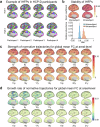Development of areal-level individualized homologous functional parcellations in youth
- PMID: 40691311
- PMCID: PMC12280106
- DOI: 10.1038/s42003-025-08509-7
Development of areal-level individualized homologous functional parcellations in youth
Abstract
Individualized functional brain networks from childhood to adolescence undergo varying patterns of maturation, associated with higher-order cognition outcomes. However, the developmental trajectory patterns based on homologous areal-level brain parcellations remain elusive. Here, we developed an individualized homologous functional parcellation technique (IHFP) to map brain functional development using resting-state functional magnetic resonance imaging data from the Lifespan Human Connectome Project in Development study (N = 591) aged 8-21 years. We delineate developmental trajectories based on areal-level homologous parcellations of resting-state functional connectivity. We found functional features during adolescence exhibit unique developmental trajectories, such as global mean functional connectivity with a widespread decrease across cerebral cortex. Then, we matched areal-level parcellations into large-scale networks and demonstrated that higher-order transmodal networks exhibited higher variability between developmental trajectories in areal-level parcels. We reveal that IHFPs possess a stronger capability for creating more homogeneous parcels in individuals, consequently showing a higher accuracy in predicting cognition behaviors. Together, these results establish the fine-grained areal-level functional homologous parcellations in adolescent development and will facilitate the understanding of human brain function more precisely.
© 2025. The Author(s).
Conflict of interest statement
Competing interests: The authors declare no competing interests.
Figures





Similar articles
-
Individual-Specific Areal-Level Parcellations Improve Functional Connectivity Prediction of Behavior.Cereb Cortex. 2021 Aug 26;31(10):4477-4500. doi: 10.1093/cercor/bhab101. Cereb Cortex. 2021. PMID: 33942058 Free PMC article.
-
A Method for Estimating Dynamic Functional Network Connectivity Gradients (dFNGs) From ICA Captures Smooth Inter-Network Modulation.Hum Brain Mapp. 2025 Jul;46(10):e70262. doi: 10.1002/hbm.70262. Hum Brain Mapp. 2025. PMID: 40626410 Free PMC article.
-
Connectivity trajectory across lifespan differentiates the precuneus from the default network.Neuroimage. 2014 Apr 1;89:45-56. doi: 10.1016/j.neuroimage.2013.10.039. Epub 2013 Nov 25. Neuroimage. 2014. PMID: 24287438 Free PMC article.
-
Pathological laughter and crying: insights from lesion network-symptom-mapping.Brain. 2021 Nov 29;144(10):3264-3276. doi: 10.1093/brain/awab224. Brain. 2021. PMID: 34142117 Review.
-
Dietary interventions for recurrent abdominal pain in childhood.Cochrane Database Syst Rev. 2017 Mar 23;3(3):CD010972. doi: 10.1002/14651858.CD010972.pub2. Cochrane Database Syst Rev. 2017. PMID: 28334433 Free PMC article.
References
-
- Eickhoff, S. B., Yeo, B. T. & Genon, S. Imaging-based parcellations of the human brain. Nat. Rev. Neurosci.19, 672–686 (2018). - PubMed
MeSH terms
Grants and funding
LinkOut - more resources
Full Text Sources

